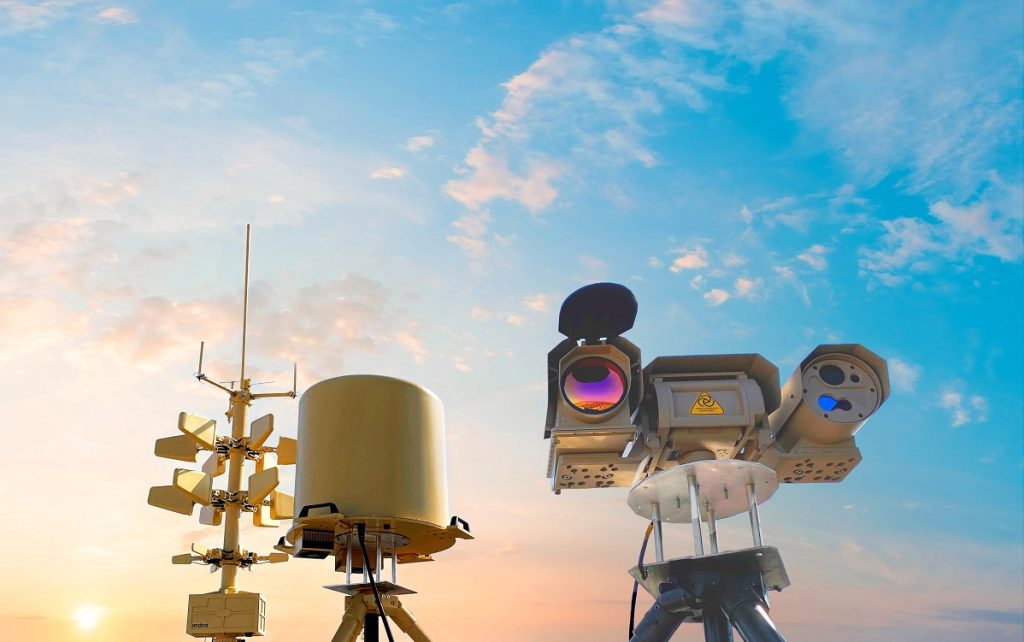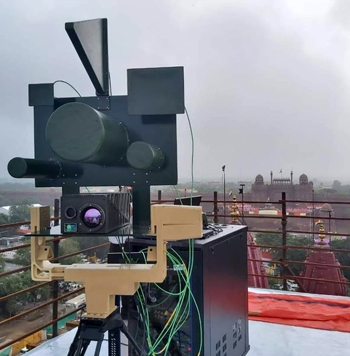Key Components of a CUAS Systems: From Radar to Response
The threat created by harmful or illegal unmanned aerial systems (UAS) is expanding quickly in a world where drone technology is used more and more for commercial, military, and social reasons. Malicious drones represent major threats to vital facilities, public safety, and national security, whether they are being used for covert operations, smuggling, disruption, or even direct criminal activity. Counter-Unmanned Aircraft Systems (CUAS) have therefore become crucial defense tools.
To detect, identify, track, and eliminate drone threats, a CUAS system is a multi-layered, integrated defense architecture. However, what constitutes a CUAS solution? From radar detection to final response, this article explains the essential elements of CUAS systems and how each layer helps to protect airspace.
Table of Contents

1. Understanding CUAS Systems
CUAS systems are a connected collection of technologies instead of each being a single piece of hardware. Usually, these systems are placed in nearby areas of important sites, including airports, military installations, detention centers, government buildings, energy plants, and public gathering places.
At a high level, a CUAS system has four functional layers:
- Detection – Identifying the presence of a drone.
- Identification & Classification – Distinguishing drone types and intent.
- Tracking – Monitoring the drone’s location and trajectory.
- Mitigation/Response – Neutralizing the threat or alerting authorities.
Each of these layers is composed of specialized hardware and software components, which we’ll now explore in detail.
2. Detection: Eyes on the Sky
The first stage in a CUAS system is detection. The effectiveness of the response will increase with the early and exact identification of a drone. The following technologies, either alone or in combination, can be used for detection:
a. Radar Systems
The foundation of long-distance drone detection is radar. CUAS radars are specifically made or adjusted to identify slow-moving, low-altitude, and small radar cross-section (RCS) targets, in contrast to conventional radars that might have trouble detecting drones.
Key features:
- 3D radar with azimuth, elevation, and range tracking
- Pulse-Doppler and FMCW (Frequency Modulated Continuous Wave) technologies
- AI-based clutter rejection to reduce false positives from birds or debris
Examples include:
- Active electronically scanned array (AESA) radars
- Low-power passive radars for urban or covert applications
b. Radio Frequency (RF) Sensors
The process of RF detection entails searching the electromagnetic radiation for monitoring links or drone control signals. Since many commercial drones use dependable radio frequency channels (2.4 GHz, 5.8 GHz), RF sensors can identify them.
Benefits:
- Detects drones before takeoff if the controller is powered on
- Useful in GPS-denied environments
- Can identify the make/model based on signal signature
Limitations:
- Ineffective against autonomous drones with no RF links
- Crowded RF environments may lead to interference
c. Electro-Optical and Infrared (EO/IR) Cameras
EO/IR sensors provide visual confirmation of a target, often used in conjunction with radar or RF detection for target verification.
- EO cameras offer high-resolution daylight imaging
- IR sensors detect heat signatures, especially useful at night
- PTZ (Pan-Tilt-Zoom) features allow for dynamic tracking
While EO/IR cameras are rarely primary detection tools due to their narrow fields of view, they are invaluable for identification and situational awareness.
d. Audio Sensors
The rotating blades and motors of drones provide unique audio characteristics. These sounds can be detected and connected using microphone systems.
Pros:
- Passive and hard to jam
- Low-cost and easy to deploy
3. Identification and Classification
Detection alone is not enough; the system must determine if the object is a drone, what kind of drone it is, and whether it represents a threat.
a. AI-Powered Classification Engines
AI and machine learning algorithms analyze sensor data—especially from radar and EO/IR feeds—to distinguish drones from birds, helicopters, or other airborne objects. Training data from known drones improves classification accuracy over time.
b. Drone Fingerprinting
RF analyzers can extract unique identifiers (MAC address, signal modulation, etc.) to identify specific drone brands or even individual units. When making allowlists and blocklists in protected airspace, this is really helpful.
c. Data Fusion Engines
Multi-sensor fusion engines integrate data from radar, RF, EO/IR, and audio sensors to provide a unified, accurate picture of the airspace. This reduces false positives and enables real-time decision-making.

4. Tracking: Maintaining the Threat Picture
Once a drone is identified, continuous tracking is crucial to assess intent, predict its path, and coordinate a response.
a. Sensor Fusion for Real-Time Tracking
Advanced CUAS systems use Kalman filters and AI-enhanced tracking algorithms to maintain lock-on capabilities even when a drone momentarily disappears from one sensor’s view (e.g., behind a building).
b. Geolocation and Trajectory Analysis
Some systems calculate the drone’s flight path and control source location using RF triangulation, GPS overlays, or radar Doppler shifts.
Emergency response dashboards featuring 3D place maps, drone ID labels, and threat levels are frequently used to show real-time tracking data.
5. Response: The Last Line of Defense
The most important and regulated component of any CUAS systems are anticipation or reducing damage. This could involve passive security measures or active limitation, depending on the local regulations.
a. RF Jamming
RF jammers interfere with the drone-controller communication by flooding areas with noise at particular frequencies (2.4 GHz, 5.8 GHz, GNSS bands).
Types:
- Directional (longer range, targeted)
- Omnidirectional (360° coverage)
Challenges:
- Legal restrictions in many countries
- Risk of collateral disruption to nearby communications
- Ineffective against autonomous drones
b. GNSS Spoofing
Spoofers send false GPS signals to mislead the drone into landing or returning to a designated location.
Pros:
- Stealthy and silent
- Can redirect drones instead of destroying them
Cons:
- Only effective on GPS-reliant drones
- May require precise synchronization
c. Protocol Takeover (Cyber Takeover)
This advanced method exploits vulnerabilities in drone communication protocols to take control of the drone.
Advantages:
- Safe landing or redirection
- Minimal collateral impact
Limitations:
- Only works on known protocols or specific brands
- Requires deep reverse engineering
d. Control of Motion
Physical takedown methods include:
- Nets fired from launchers or interceptor drones
- Projectile-based systems (e.g., anti-drone guns)
- Laser or microwave weapons (for military or high-security zones)
These are typically used when soft-kill methods fail or are not viable.
6. Command and Control (C2) & User Interface
All CUAS components are integrated into a central Command and Control (C2) system that provides:
- Unified operational dashboard
- Sensor feeds and alert logs
- Real-time threat visualization
- Alerting and escalation mechanisms
- Manual and automatic countermeasure triggers
A good C2 interface enables quick decision-making, integrates with third-party systems (e.g., security cameras, air traffic control), and maintains audit trails for post-event analysis.

7. Deployment Models: Fixed, Mobile, and Portable
CUAS systems come in various deployment formats depending on the use case:
- Fixed installations for infrastructure protection (e.g., nuclear plants, airports)
- Mobile systems mounted on vehicles for border security or battlefield use
- Portable units like handheld drone guns or backpack radars for tactical missions
Hybrid deployments combine fixed and mobile units for layered defense.
8. Legal and Ethical Considerations
Deploying CUAS systems comes with legal constraints:
- In many countries, jamming and spoofing are restricted or require government authorization.
- Civilian drones often operate in the same spectrum as Wi-Fi and GPS, increasing the risk of unintentional disruption.
- Identification and classification must balance security with privacy.
Operators must ensure compliance with local regulations and coordinate with civil aviation authorities.
9. Emerging Trends in CUAS Technologies
As drone technology evolves, so too must counter-drone systems. Key trends shaping the future of CUAS include:
- AI-enhanced threat prediction using behavioral models
- 5G-enabled low-latency communications for faster response
- Autonomous interceptor drones
- Swarm detection algorithms to counter multiple simultaneous threats
- Integration with airspace management platforms (UTM)
Additionally, increased miniaturization and power efficiency are making CUAS systems more accessible and affordable.
Conclusion
A CUAS system’s ability to combine several elements—radar, RF sensors, EO/IR cameras, audio sensors, and powerful reduction tools—into a unified, intelligent defense platform determines how successful it is. From early detection to the final response, every element is important.
CUAS systems must continue to be flexible, scalable, and legal in their localities as drone threats grow more complex and general. Organizations in charge of major events, vital infrastructure, or public safety must view CUAS systems as necessary components of current security architecture rather than as costly items.
The first step in securing the airspace includes knowing the key components of a CUAS system, whether you’re protecting a power station, an international airport, or a military operation.

